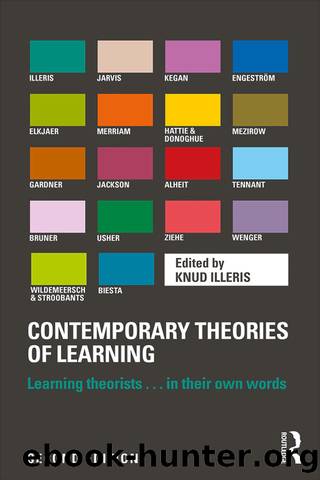Contemporary Theories of Learning by Knud Illeris

Author:Knud Illeris
Language: eng
Format: mobi
ISBN: 9781138550483
Publisher: Taylor and Francis
Published: 2018-03-26T22:00:00+00:00
Generalizing the approach
Even if I have achieved some success in suggesting how best to approach two gritty topics of education, I evidently have left untouched the vast majority of the curriculum. My focus has been on a high school â perhaps a college â pair of topics; I have drawn from biology and European history, rather than from mathematics, music, or meteorology; and I have focused on topics or issues, rather than, say, specific chemical reactions, or metrical analyses, or geometric proofs.
I would be remiss were I to imply that the approach sketched here could be applied equivalently to every topic of the syllabus. Indeed, I deliberately selected two topics that are relatively rich and multifaceted, and that readily allow consideration from several perspectives. I suspect that no pedagogical approach is going to prove equally effective for the full range of topics and skills that need to be conveyed; teaching French verbs or the techniques of Impressionism is simply not commensurate with covering the Russian Revolution or explicating Newtonâs laws of mechanics.
Still, the approach sketched here can have wide utility. First of all, it raises the question of why one is teaching certain topics and what one hopes that students will retain at some time in the future. Much of what we teach recurs through habit; it makes sense to teach fewer topics and to treat them in greater depth. Such an approach allows one to relate materials to a few central themes â like evolution in biology, or the Holocaust in history (or energy in physics, or character in literature) â and to eliminate topics if they cannot be reasonably connected to some powerful themes or throughlines. After all, we cannot conceivably cover everything; we may as well strive to be coherent and comprehensive in what we do cover.
Having determined which topics require sustained attention, one can then exploit an ensemble of pedagogical approaches. To recapitulate: one begins by considering which entry points might succeed in attracting the interest and attention of diverse students. One then considers which kinds of examples, analogies, and metaphors might convey important parts of the topic in ways that are powerful and not misleading. Finally, one seeks to find a small family of literally appropriate representations that, taken together, provide a rich and differentiated set of representations of the topic under consideration. Such an ensemble conveys to students what it is like to be an expert. And to the extent that the family of representations involves a range of symbols and an array of schemes, it will prove far more robust and useful to students.
Presenting materials and fostering multiple representations is one component of effective teaching; the complementary component entails the provision of many opportunities for performance, which can reveal to the student and to interested observers the extent to which the material has been mastered. In stimulating revealing performances of understanding, teachers need to be imaginative and pluralistic. While it is easy to fall back on the tried-and-true â the short-answer test, the essay question â there is no imperative to do so.
Download
This site does not store any files on its server. We only index and link to content provided by other sites. Please contact the content providers to delete copyright contents if any and email us, we'll remove relevant links or contents immediately.
The Art of Coaching Workbook by Elena Aguilar(48057)
Trainspotting by Irvine Welsh(20052)
Twilight of the Idols With the Antichrist and Ecce Homo by Friedrich Nietzsche(17705)
Fangirl by Rainbow Rowell(7832)
Periodization Training for Sports by Tudor Bompa(7327)
Change Your Questions, Change Your Life by Marilee Adams(6639)
This Is How You Lose Her by Junot Diaz(5764)
Grit by Angela Duckworth(4734)
Red Sparrow by Jason Matthews(4661)
Asking the Right Questions: A Guide to Critical Thinking by M. Neil Browne & Stuart M. Keeley(4573)
Paper Towns by Green John(4168)
Room 212 by Kate Stewart(4102)
Ken Follett - World without end by Ken Follett(3972)
The Sports Rules Book by Human Kinetics(3585)
Housekeeping by Marilynne Robinson(3401)
The Motorcycle Diaries by Ernesto Che Guevara(3332)
Introduction to Kinesiology by Shirl J. Hoffman(3299)
Exercise Technique Manual for Resistance Training by National Strength & Conditioning Association(3290)
Double Down (Diary of a Wimpy Kid Book 11) by Jeff Kinney(3272)
